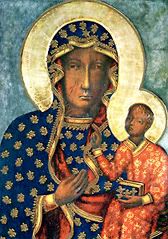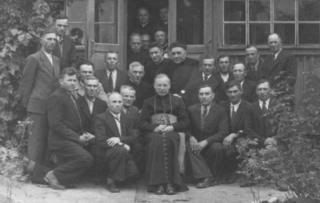After the war, Fr. Wyszynski returned to his home diocese of Wloclawek. Whereas, before the war, he had been greatly drawn to academic work, Providence was about to mark his destiny as that of a pastor and father to the nation. As always, his heavenly Mother would accompany him on each stage of the journey.
Our Lady of Czestochowa
On the feast of the Annunciation, March 25, 1946, Cardinal Hlond, the Primate, summoned Fr.
Wyszynski to Poznan to inform him that Pope Pius XII, had nominated him as Bishop of Lublin.
Convinced that the call of Christ and the Holy Father could not be refused, Fr. Wyszynski resigned himself to leaving Wloclawek, and with it, the joy of serving as professor, editor, and social activist.

Augustin Cardinal Hlond
The date of his consecration was set for May 12 at his beloved Jasna Gora, where he had offered his first Mass. Bishop-elect Wyszynski decided to include the Madonna of Jasna Gora-Virgo Auxiliatrix in his coat-of-arms. Later, he would say that this was not meant merely as a decoration or symbol, but rather as a program of his work in the Church of Poland.

Bishop Wyszynski's Coat of Arms
Before his consecration, he made an eight-day retreat in Czestochowa to prepare himself for his coming mission. Consecrated on May 12, 1946, feast of Our Lady of Grace, Stefan Wyszynski was strengthened in his sense of living under Our Lady's special care.
As Andrzej Micewski relates to us, "Later, as Primate, instead of precious stones and saints' relics, Wyszynski's ring carried a likeness of the Madonna of Czestochowa. Eventually, he would expand his personal motto from Soli Deo to Per Mariam Soli Deo. His consecration picture bore the inscription Mother of God's Grace!'
His eyes firmly fixed on his heavenly Mother, and his hand firmly holding hers, Bishop Wyszynski issued one of his first pastoral letters in August, on the day of the dedication of the Polish nation to the Immaculate Heart of Mary, explaining the ways in which this dedication springs from history.
Doing everything possible to teach his people to love the Mother of God, he issued another pastoral to school-age children on the daily recitation of the Rosary, while convening a Rosary congress on July 2, l947. The following year, on Sept. 7, he convened the first Marian congress in Chelm.
Bishop Wyszynski in 1947
With the new bishop's reputation as a good and holy shepherd spreading, the Primate, Cardinal Hlond, remarked to a visitor that Bishop Wyszynski had made a great impression on him, calling him, 'young, intelligent, and brave.' (Micewski, 40)
Three years later, a dying Cardinal Hlond would write Pope Pius XII, requesting that the Bishop of Lublin be named his successor. Unbeknownst to him, the Polish episcopate would also be making the same request.
The dying Cardinal Hlond's spiritual testament would be the program of his successor, "Keep working under the protection of our Blessed Mother. Victory, when it comes, will be the victory of the Most Blessed Virgin. Nil desperandum! (Never despair!)' (Micewski, 42)
When the funeral of Augustine Cardinal Hlond came, the Catholics who filled the capital of Warsaw to be pay tribute to their primate looked to the future with heavy hearts, as the Soviet-controlled government had just introduced the first five-year plan to Communize the country.
Many wondered whether the next man to be elevated to the highest ecclesiastical office in Poland would not also be taking on with it a condemnation to martyrdom.
On November 12, 1948, the feast day of the five martyred Polish brothers, Pope Pius XII named Stefan Wyszynski as Archbishop of Gniezno and Warsaw, Primate of Poland. The nominating letter was signed on November 16, the feast day of the Blessed Virgin of Ostra Brama, to whom the Primate's mother had such great devotion.
The future treatment the new Archbishop would receive at the hands of the Communists was made clear as the new Primate traveled along the road to Gniezno. Although everyone already knew who the traveler was, his car was repeatedly stopped and his identity checked along the way.
Continuing his life-long path of consecration to Mary, Archbishop Wyszynski's ingress to Gniezno occurred on Candlemas, the Feast of the Purification of the Blessed Virgin Mary, February 2, 1949.





1 comment:
Is there to be a Part III? I would love to hear how the story finishes.
Post a Comment